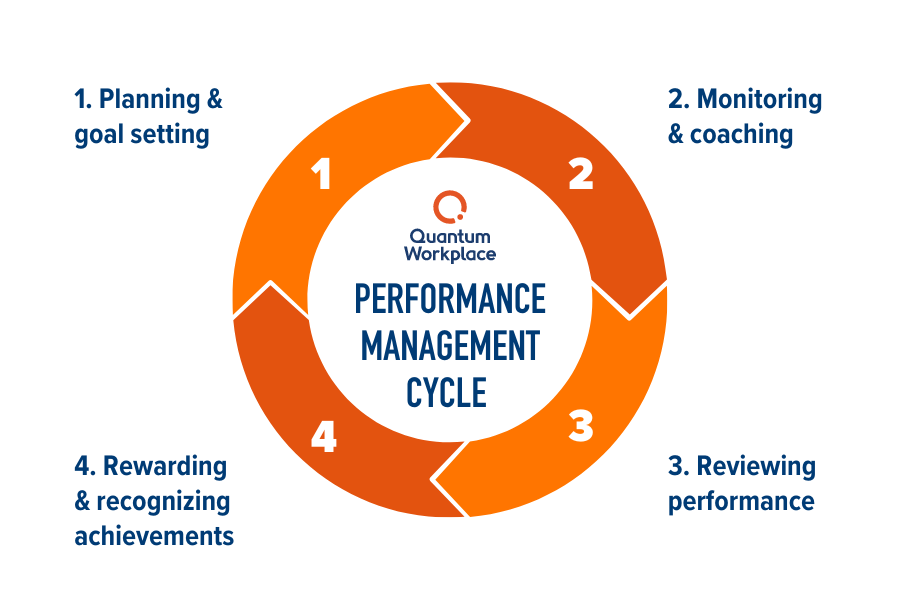What is Performance Management? HR’s Guide to a Strategic Program and Process
It’s a universal desire for everyone—employees, managers, and leaders—to see employees succeed. Employee performance is a cornerstone of a thriving culture and a successful business. Yet, traditional performance management methods fall short in inspiring employees to do their best work. They lack the clarity, connection, and coaching that today’s workforce seeks.
An optimal performance management program goes beyond evaluation. It humanizes employee contribution, transforms managers into coaches, and integrates employee engagement into daily operations to drive growth. But how do you build processes and tools that help you get here?
The journey to inspire employee performance hinges on two pivotal factors: your performance management approach and the technology you embrace. But research says organizations aren’t hitting the mark on either of these factors.
- Less than half of employees say their organization’s approach to performance management is effective, efficient, or engaging.
- Two-thirds of employees thinking about leaving their job express dissatisfaction with performance management technology and tools.
What is performance management?
Performance management is an organization’s systematic approach to defining goals, tracking progress, and delivering feedback to boost employee and organizational performance. Effective performance management ensures employee contributions align with important organizational goals.
Understanding the performance management cycle
Your performance management cycle needs to be simple, clear, and valuable for everyone involved. It should help you:
- Drive alignment and connection
- Strengthen engagement and retention
- Empower, celebrate, and motivate employees
- Build managers who are strong performance coaches

Organizations often view a performance management cycle in separate stages, but the most impactful programs incorporate a web of integrated activities that work together to boost employee and business success. The key components include:
- Planning and goal setting
- Monitoring and coaching
- Reviewing performance
- Rewarding and recognizing achievements
How does performance management differ from performance appraisals?
Performance management and performance appraisals are distinct yet related concepts. A performance appraisal is an annual evaluation, typically focused on past performance. It often feels static and retrospective, and therefore ineffective.
Conversely, performance management is a continuous, dynamic process. Rather than a once-a-year event, it involves regular dialogue between employees and managers, facilitating real-time feedback and ongoing development.
The right performance management system creates a more engaging and interactive process that empowers employees to take charge of their own performance—and giving managers resources to support their team effectively.
Why is performance management important?
A study by Harvard Business Review Analytic Services found more than half of business leaders chose productivity as a primary business goal for their organization's investments in performance management, employee engagement, and career development. Yet only 31% say they have improved productivity as a direct result. This is where performance management comes in.
Performance management is crucial for several reasons, including:
- Employee engagement: Regular feedback and clear expectations increase employee involvement and commitment.
- Productivity: Continuous performance dialogue helps individuals align their efforts with company goals, leading to higher productivity.
- Professional development: Employees have clear career pathing for growth and development, improving their skills and career prospects.
- Trust: Ongoing communication and alignment builds trust and understanding between staff and management.
- Organizational success: A well-implemented performance management system aligns individual performance with important company objectives.
- Training priorities: Consistent assessments can reveal gaps in skills, guiding where to focus training efforts.
- Retention: A culture that fosters growth and values contributions can help retain top performers.
- Compensation and promotions: Performance management provides a basis for making informed decisions about pay raises and advancement.
- Customer satisfaction: Ongoing coaching and development keeps employees aligned, motivated, and equipped to meet customer needs effectively and consistently.
Purpose of performance management
It’s clear that performance management is an essential part of business success. There are many reasons for performance management. When designed and implemented correctly, your performance management program has the power to:
- Clarify and reinforce expectations and accountabilities
- Align goals under the organization’s vision and mission
- Engage and retain top performers
- Develop and grow employees, personally and professionally
- Encourage critical thinking, agility, and creativity
- Motivate employees toward success
It impacts employee success
Your employees have unique responsibilities, strengths, contributions, and experiences that help (and sometimes hinder) performance. How they go about achieving their goals might look a little different. Performance management impacts employee performance by ensuring employees have:
- Clear goals and priorities
- An understanding of performance expectations
- Insights into how they’re performing
- Frequent feedback and coaching from managers
It impacts team success
Many businesses have shifted from rigid organizational hierarchies to more effective and agile team-based models and cultures. Performance management increases accountability and ownership with transparent and aligned goals. It helps leaders build positive relationships between team members, create a culture of feedback, and develop high-performing teams.
It impacts organizational success
Workplaces need to bring people, processes, and systems together to get work done. When individuals and teams understand how and why their contributions impact business results, they’ll be more likely to continue contributing to business success. Performance management impacts business performance by helping businesses promote transparency, alignment, and collaboration so that all employees and teams are working together to reach a common goal.
History of performance management
Performance management has taken many shapes over the years and eventually went on to shape what we now categorize as the “traditional performance appraisal approach”. This looked at an employee’s individual performance by:
- Setting goals at the beginning of the year
- Working on those goals throughout the year
- Reviewing performance against those goals at the end of the year
- Determining compensation and bonuses based on the review of these goals
Historically, employees were categorized as high, middle, or low performance workers, and contributions were measured by output versus outcomes.
Given that the original performance management systems were built to suit workplaces at the turn of the 20th century when work environments were much different, they’ve received an upgrade over the years.
As theories on employee motivation and satisfaction have been more widely understood, more participative and developmental forms of assessment have been introduced. The rise of technology and data analytics drove this shift, enabling more frequent, detailed, and personalized feedback throughout the year.
The shift to continuous performance management
As businesses have evolved over time, so has performance management. Today, organizations are leveraging their talent as a competitive advantage and prioritizing innovation and critical thinking over execution. This evolution has inspired a shift from annual appraisals and goal management to continuous performance conversations and feedback.
Implementing a continuous performance management approach allows leaders to capture real-time data and coach toward ongoing progress.
Peter Cappelli, Director of the Center for Human Resources at The Wharton School of Business at the University of Pennsylvania, outlines three reasons for adopting a continuous performance management approach:
1.) employees want more ownership over their development and advancement
2.) managers want high performing teams with a unified purpose
3.) businesses need systems that help them be more agile and collaborative
What does a continuous performance management approach look like?
To sum up everything we’ve discussed above, continuous performance management drives high performing teams through alignment, frequent goal updates, and ongoing performance conversations. It involves:
- Performance reviews: quarterly performance conversations focused on performance and development.
- Goals: individual and team goals roll up into organizational goals, and individualized employee development goals.
- 1-on-1s: weekly check-ins between managers and employees and dedicated career growth and development conversations throughout the year.
- Talent reviews: manager feedback on employee impact, growth trajectory, and retention risk based on quarterly performance conversations.
- Succession planning: leaders identify and develop candidates for critical roles for the organization’s current and future success.
Transitioning from traditional to continuous performance management doesn’t have to happen overnight. Organizations need to recognize that there are various approaches between these two extremes. Finding the middle ground is an important evolution that can help you make progress.
Download our Performance Pathways eBook to help design your performance management approach
How to reevaluate your performance management approach
Knowing when to reevaluate your performance management approach is crucial to maintaining a productive and engaged workforce. If your current system isn’t yielding the desired results, it might be time for a change.
Quantum Workplace research shows less than half of employees say their organization’s current performance management process is a good use of their time. And less than half say it’s easy and efficient.
Signs your performance management process needs improvement
A few key signs can point to the need for changes in your performance management process. These are a few red flags to look out for:
- Stagnant employee growth: If you notice that employees are not developing their skills or advancing in their roles, your performance management process may lack the necessary support for their growth.
- Low morale and engagement: A drop in team morale or a lack of enthusiasm for work can indicate that your performance strategy isn't providing the motivation or recognition that employees need.
- Ineffective or lack of feedback: When feedback is infrequent, not constructive, or one-sided, employees miss out on valuable insights that could drive their performance.
- Unclear objectives: If employees are unclear about what is expected of them, it's a sign that goals and benchmarks are not effectively communicated within your current system.
- High turnover rates: An increase in staff turnover might suggest that your performance management is not meeting employee needs for career development and satisfaction.
- Lack of alignment with business goals: Performance management should be tightly aligned with the overarching goals of your business. A disconnect here could mean your approach needs realignment.
- Ineffective or ill-equipped managers: As we highlighted earlier, managers play a key role in performance management, and if they aren't properly trained to coach and provide feedback, the whole system suffers.
If any of these signs resonate with your current situation, it's time to take a closer look at your performance management approach. A successful revamp can create a more dynamic and supportive environment that empowers employees to do their best work and help the organization achieve more.
Ready to evolve your performance management approach? Download our eBook for tips on how to navigate the change
3 steps to improve your performance management process
If you are recognizing the need to revamp your performance management process based on what you read above, three steps can help get you started.
1. Conduct an audit of your current performance management process.
To design a successful performance management program for the future, you need to assess your past and current experience. HR leaders must review and update these practices frequently to keep up with industry, marketplace, and workplace trends, as performance management is a continuous process.
Ask yourself:
- Do our processes and systems align with the pace of our business?
- How does our current process help us achieve our org-wide goals?
- What gaps or blind spots do we have with our current process or system?
2. Make sure to involve employees.
Rather than performance management happening to employees, they should be a critical part of the process through shared goal setting, multidirectional feedback, and continuous conversations.
In a survey, 81% of respondents strongly agree that highly engaged employees perform better. And organizations have been capitalizing on improving employee engagement for years.
Ask yourself:
- Do our employees have what they need to perform at their highest level?
- How are we helping coach employees to leverage their strengths?
- What other support or training do they need to own their performance?
3. Create an agile approach.
Annual goals can become quickly dated if organizational changes occur. Keep your biggest business objectives and key results top of mind and updated. Build a process that gives you a detailed view of real-time employee performance—so managers can actively retain and develop their team.
Ask yourself:
- Do our managers have what they need to be successful performance coaches?
- Are we using the right tools to help us adapt and adjust organization-wide performance goals?
- Do employees understand how their goals align with business outcomes?
|
How Fossil Transformed Their Performance Management ProcessFossil Group saw immediate progress when it evolved its company-wide performance approach—however upon further analysis it found that 35% of individual goals were misaligned or lacked impact on strategic priorities. Here’s how they adapted for business success: They moved to continuous performance conversations and feedback by implementing informal “check-ins” that could be launched and customized by any employee, at any time. They built intuitive goal conversation templates to organically include opportunities to discuss and collaborate on setting clear, aligned, and motivating goals. They brought performance conversations full circle by building recognition toolkits for managers and launching an online peer-to-peer recognition program to keep the conversation going. |
How to build an effective and thriving performance management program
After you’ve evaluated the current state of your performance management process, it’s time to start building your new program.
Set performance management goals
Before you can determine the “what” of your performance management programs and tools, take the time to ask your leaders and HR team about the “why.”
What do you want performance management to do for the organization? How will you know if the program you build is successful?
Effective performance management is more than just a box to check. It’s the driving force behind employee and business success. Your performance management system should serve as the framework that organizes all the critical components of your process—informed by the unique priorities and goals of your organization.
Performance management best practices
You’ll want to follow a few key performance management best practices to maximize the success of your approach.
1. Shared ownership
Like other workplace initiatives, performance management is not solely an HR function. Performance management programs require ownership and involvement of all employees to be effective. Buy-in should start with senior leadership, but that’s not where it ends. Make sure you explain the unique benefits and components of the program to employees, managers, and leaders.
2. Fair performance evaluation
Leaders need to prioritize honest, inclusive, and ongoing feedback to make the experience feel fair and engaging to employees. Don’t save all your feedback for an annual performance review. Instead, align, assess and adjust throughout the year.
3. Frequent performance conversations
Solely relying on annual employee performance reviews can be subject to bias due to depending on memories and recollection of past performance and behavior. By supplementing with more flexible, two-way conversations (or check-ins) you’ll enable employees and people managers to shape a shared agenda and discussion.
One-on-one meetings should happen at least monthly to allow managers and employees to discuss performance and other important topics frequently. These meetings can cover a variety of topics and should always be:
- Developmental and future-focused
- Transparent and timely
- Inclusive of the employee voice
- Aligned with employee aspirations
4. Collaborative goal setting
When managers and employees set goals collaboratively—and frequently—employee engagement increases. Managers should work with employees to set individual goals that align with team and organizational goals. This helps employees see how their work is contributing to the success of the organization.
5. Frequent, multi-sourced feedback
Whether feedback is positive or corrective, it shouldn’t have to wait until the end of the year. In fact, 71% of employees prefer immediate feedback and 72% said their performance would improve if their managers provided corrective feedback.
Be sure to add peer feedback to help paint a broader, clearer picture of employee performance. Managers don't always have a direct line of sight into their employees’ performance or developmental needs—360 feedback helps!
6. Opportunities for development and training
68% of millennials who feel they’ve had development opportunities at work in the past year plan to stay at their organization for at least another year. But employee growth and development are not one-size-fits-all initiatives. Make sure your managers are in tune with employee needs and desires by making growth and development conversations a central pillar of your program.
7. Recognition and appreciation alongside compensation
Traditional performance management approaches offer compensation (or pay-for-performance) to reward high performers. But today’s workforce isn’t motivated by monetary benefits alone.
While compensation conversations are still important, organizations are separating pay from performance and emphasizing positive feedback and recognition to increase engagement and motivate performance. Recognition should go beyond employees' individual contributions and celebrate the behaviors that support and reinforce your organization's mission, vision, and values.
8. Digital tools that make it easy for everyone
Organizations are employing workers of all types: remote, temp, hourly, and salaried. No matter the makeup of your organization, you need HR technology that links teams and their performance. With the right digital tools:
- Employees can set goals, schedule check-ins, provide feedback and recognition, and stay connected between check-ins.
- Managers will have greater visibility and transparency on goal progress and performance, employee recognition, and feedback.
- Organizations won’t be dependent on "seeing" employees to understand their performance and how it does (or doesn’t) impact business.
Frameworks for building your performance management program
When it comes to performance management, not just any old shoes will fit. Building the right program for your unique organization is a journey. But you don’t need to start from scratch. To transition to a more continuous approach organizations should:
- Take one small step. That can be increasing feedback frequency or starting a regular 1-on-1 cadence.
- Get employee input. Gain their buy-in by getting their feedback on the change.
- Help managers. Managers need training to transition from evaluators to coaches.
- Use tech. Our research shows that managers and employees need robust technology to integrate performance management into their daily workflows.
- Communicate. The entire organization needs to understand the approach and benefits.
- Analyze and act. Take the feedback you receive on the new process and adjust to make the process better.
Quantum Workplace offers ready-made, customizable frameworks to help you hit the ground running on your next performance management evolution.
Learn more about our Performance Pathways
How to identify effective digital performance management tools
Choosing the right performance management tool to fit your workplace culture is essential to the success of your strategy. When looking for the right tech, you need a solution that brings elements of an effective system together.
Look for a provider that isn’t limited to standalone systems or tools. Instead search for one that supports and propels organizational growth.
Key tools you need in performance management software
|
|
Move your teams forward with clear and aligned goals.Setting clear and aligned goals is paramount to the success of high performing teams. Quantum Workplace empowers your teams to set, monitor, and accomplish important goals with:
|
Boost trust and employee performance with employee feedback.Quantum Workplace’s 360, peer, and upward feedback help boost employee performance, growth, and development. Support a culture of continuous feedback within your teams with:
|

|
Keep managers and employees on the same page with performance reviews.Performance reviews are still a staple of most performance management programs—but you need them to be more effective, efficient, and engaging to improve performance. Make performance conversations simple and effective with:
|

|
Celebrate success and help team members feel valued with real-time recognition.Motivate employees and celebrate success with real-time recognition. Easily share stories of success and help employees across your organization feel valued with:
|
|
|
Increase clarity and connection with performance reviews and 1-on-1 meetings.Empower meaningful conversations at every level, across any department. Increase communication, clarity, and engagement with:
|

|
Identify and develop top talent with talent reviews.Objectively assess performance to identify rising stars and talent risk. Make strategic talent decisions with:
|
Sustain high performance with succession planning.
|
|
Sustain high performance with succession planning.Proactively identify gaps and create development plans to prepare for the future. Ensure the right successors are identified and developed with:
|
Other performance management platform must-have features
1. Integrates with your HRIS.
Make sure your new performance management system integrates with not only your existing Human Resource Information System (HRIS), but other systems and databases to remove the administrative burden of getting started.
You want information to flow seamlessly, providing HR professionals, managers, and employees with current and precise data. Avoid isolated data pools and minimize the need for manual entry, thereby improving operational efficiency.
2. Customized to fit your culture.
For a performance management program to be welcomed and adapted by your employees, it must feel like a natural part of your organizational culture. That means your performance management software should be customizable to fit the needs of your organization so that it becomes ingrained and integrated with other processes and traditions.
3. In-tool nudges and alerts.
Busy schedules are a big obstacle when it comes to effective and continuous performance management processes. Look for software with in-tool and email notifications that notify and surface important insights and actions to managers.
4. Mobile app or access.
Help employees of every level track and motivate performance no matter where they work (and when). Make sure your performance management software can be accessed from computers, tablets, and mobile devices.
5. Access to integrated performance tools.
The best performance management software allows you to integrate all your performance tools in one place—including goals, 1:1s, recognition, feedback, and talent reviews. Find software that allows users to access them all with one, simple login to decrease hassle and increase usage.
6. Reliable service and support.
A user-friendly performance management system is great, but if your software partner isn’t accessible, responsive, and friendly when you (or your employees) have questions, then it’s not the system for you. Look for a vendor that includes a dedicated support team, provides resources and templates, and keeps you informed on the latest trends and research.
7. Integrates with engagement tools.
For your performance management software to be truly effective, it should be integrated with engagement tools. This integration allows you to see the effectiveness of your performance management strategies and pinpoint what drives engagement and retention among top performers.
The state of performance management is always evolving—and will likely be at the top of many business leaders and HR agendas for the foreseeable future. To continuously achieve business success, organizations will need to adapt and adjust their approach to attract and retain high-performing employees.
Changing focus from annual performance reviews to a continuous approach and creating a process that drives employee engagement, employee and team performance, and business success will help:
- Employees understand why their contributions matter and how to make a bigger impact
- Managers coach successful teams by providing continuous feedback and building aligned goals
- Leaders tie performance metrics to business outcomes to build a competitive workforce
See how Quantum Workplace’s performance management software can help you build more effective managers and teams! Get your custom demo today.








